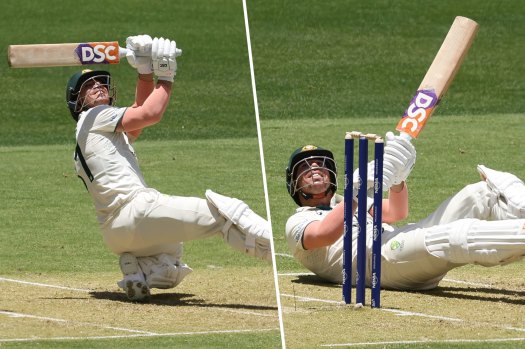Save articles for later
Add articles to your saved list and come back to them any time.
David Warner’s extraordinary scoop to Pakistan’s pace ace Shaheen Afridi was the shot of an IPL millionaire to a dime-a-dozen Test delivery.
There was a time when a fast bowler could be confident that a delivery aimed at the top of off would command the respect of a dead bat or thunder into the gloves of the keeper. In 2023, its final resting place could be in the stands.
Even in this turbocharged era, the gasps that echoed around the quarter-full Optus Stadium told of the crowd’s astonishment that Warner, despite a man placed in the fine leg region, had attempted such an audacious shot – and hit it flush despite misreading the length.
The pyrotechnic world of Twenty20, or the frenetic final overs of a one-day international, is the natural habitat of the ramp shot – not the first morning of a Test match.
David Warner was left flat on his back playing a ramp shot for six.Credit: Getty
Brad Haddin, who retired only eight years ago, said he had never thought of playing such a shot during his career. And he was not stodgy at all. In Australia’s infamous capitulation for 47 at Cape Town in 2011, the wicketkeeper/batter got out backing away to play an inside-out cover drive. The score was 5-18.
“The thought process about the modern player to score and bring 360 [degrees] into the equation is phenomenal,” Haddin said on Triple M. “That ball was top of off, going away, well bowled, to think of dropping your leg, ramp over fine leg – [it’s] extraordinary skill.”
It’s a shot that also requires bravery. If it goes wrong, you’re copping a cricket ball in the grill or wearing it on the chin from critics and past players, like Mitchell Johnson. You can imagine the feedback awaiting Warner if he had lost his wicket, laid out on his back from what he said was his misjudgment. Eleven years ago, Ricky Ponting made the call to retire days after tumbling to his knees in Adelaide.
“I actually thought it was shorter than what it was until I saw the replay, and the boys were laughing,” Warner said after play. “Uzzy [Usman Khawaja] came up and said ‘that’s an unbelievable shot’ and I said ‘it’s a short ball mate, I can ride it’ and he said ‘that wasn’t short mate, that could have been a cover drive’.”
Those not privy to watching players train do not see how much practice goes into pulling off shots that have only recently entered the cricket lexicon.
Warner has only just come out of a long white-ball campaign where such strokes are more commonplace, and the value placed on one’s wicket not at such a premium. When the two nations last met in the World Cup, he deposited a 146 km/h thunderbolt from Haris Rauf onto the roof of Bangalore’s Chinnaswamy Stadium.
Perversely for bowlers, boundaries have become shorter at a time when the array of shots in the game is expanding. Willow wielders have more powerful bats. They switch hit, reverse-sweep and ramp. As for fast bowlers? A slower-ball bouncer has the feel of a knife at a gunfight. Little wonder, then, Afridi was sporting a scowl when he squared up to Warner, who had a smile from ear to ear.
Warner is by no means the first to play a new-age stroke in the game’s traditional format. Only a few months ago, embracing the Bazball philosophy, England’s most classical batter Joe Root attempted to ramp Pat Cummins with the first ball of day four at Edgbaston. Never has there been a narrower gap in the way that white- and red-ball cricket is played.
“It’s always in the back of my mind to play that shot, it doesn’t matter what format it is, it’s a scoring shot, and nine times out of 10 they’re bowling a nice length,” Warner said. “On this wicket, it’s hard to hit the stumps. I thought with his angle and his pace I could actually ride it, so I just gave it a crack.”
What the shot also revealed was Warner’s more attacking mindset. Derided when he debuted in the baggy green as being merely a T20 slugger, Warner shook off that tag in his second Test when he carried his bat in defeat on a dicey deck in Hobart against New Zealand.
This century was only his second in 45 innings stretching back almost three years. His strike rate in that period of about 60 is well down on his career mark of 70 and, in this knock, 78. Warner has made his riches playing like a millionaire.
News, results and expert analysis from the weekend of sport sent every Monday. Sign up for our Sport newsletter.
Most Viewed in Sport
From our partners
Source: Read Full Article
